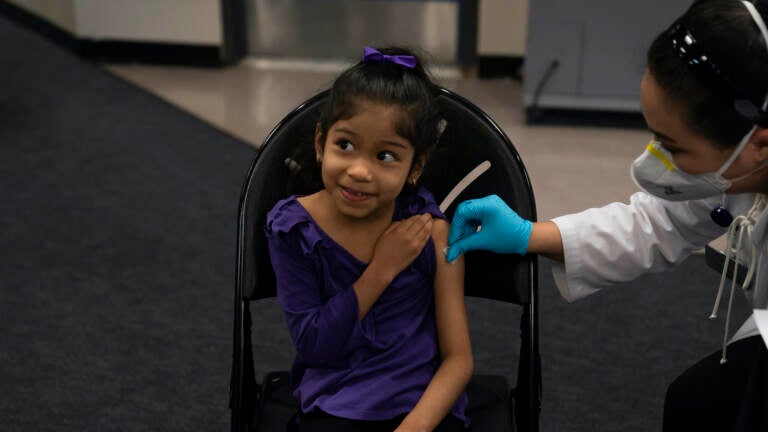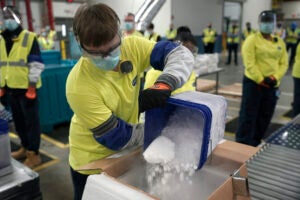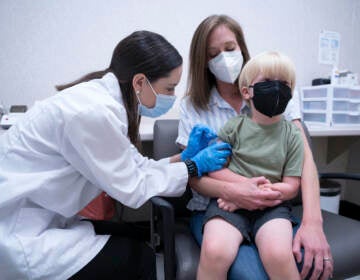Nearly 1 million kids ages 5-11 will have their first COVID shots by the end of today

Elsa Estrada, 6, smiles at her mother as pharmacist Sylvia Uong applies an alcohol swab to her arm before administering the Pfizer COVID-19 vaccine at a pediatric vaccine clinicl in Santa Ana, Calif. Tuesday, Nov. 9, 2021. (AP Photo/Jae C. Hong)
Beloved stuffed animals in hand, they lined up at schools, pop-up clinics, and children’s hospitals to do something that little kids generally hate to do: get shots. COVID vaccinations for 5- to 11-year-olds began in earnest late last week, ramping up over the weekend and early this week.
By the end of the day on Wednesday, approximately 900,000 elementary-aged children will have gotten their first doses of the Pfizer-BioNTech COVID-19 vaccine, a White House official shared with NPR in advance of an announcement expected later in the day.
That represents about 3% of children aged 5 to 11. 700,000 more have appointments scheduled in the days ahead at pharmacies like CVS and Walgreens.
“This does not include appointments being made, for example, at places like pediatricians’ offices, children’s hospitals, and other sites,” the official said.
For the White House, this is an early and encouraging sign in the effort to vaccinate 5- to 11-year-olds, though it is impossible to tell from these initial numbers whether vaccinations will continue apace or hit a plateau of hesitancy as they have with other age groups. Unlike previous expansions of vaccine availability, the Pfizer-BioNTech vaccine for these younger children comes in a smaller dose with different packaging and smaller needles.
Vaccines for this age group couldn’t be packaged and shipped until the FDA gave emergency use authorization on Oct. 29, and it’s been a dash ever since.
To rapidly reach this new population, the official says Minnesota has set up 1,100 vaccination sites including one at the Mall of America that can vaccinate 1,500 children a day. Children’s hospitals have set up family-friendly events with pets, stuffed animals, and adults in costume. New York City has more than 1,000 clinics planned in schools, with flexible hours.
Because it is a new program, comparisons are imperfect. A week after authorization of vaccines for 12- to 15-year-olds, a larger share of the eligible population had gotten their first dose than 5- to 11-year-olds so far. But adolescents were getting the same vaccine doses already widely available to adults in pharmacies and doctor’s offices all over the country, so there was no ramp-up time needed.
A recent Kaiser Family Foundation poll found only 27% of parents planned to rush right out and get their 5- to 11-year-olds vaccinated for COVID-19. A full 30% said they definitely would not get their children vaccinated. Surgeon General Vivek Murthy has raised alarms about misinformation, pleading with parents to do their research using reliable sources and to talk to their children’s pediatricians if they have questions.
Some parents have complained about having trouble finding appointments. Still, over the weekend social media flooded with pictures of masked children sporting brightly colored band-aids.
Dose #1! A good day.
Get vaccinated. Lots of options for locations and times. Check out @mnhealth for more information.
Now it’s 🍦time! pic.twitter.com/ujVl0rJWvt
— Liz Olson (@LizOlson218) November 6, 2021
“And it’s going to give millions of American parents peace of mind,” President Biden said at a virtual political fundraiser Tuesday night, touting the newly available vaccines for children.
First Lady Jill Biden is expected to travel around the country in the coming weeks, visiting schools and making direct appeals to parents to protect their children through vaccination.
The secretaries of education and health and human services earlier this week sent letters to school leaders, encouraging them to set up vaccine clinics on campuses, to distribute high-quality information about the vaccines to students’ families, and to hold Q-and-A sessions for parents with local pediatricians. The letter also flagged that there is money in the American Rescue Plan passed by Congress earlier this year to help fund these efforts.
If enough parents vaccinate their children, it could go a long way to restoring normalcy for elementary schools. Many have had to put students on “pause” after close contact with an infected classmate, disrupting in-person learning. Some school districts have even had to shut down entirely for a week or more to try to break the chain of infection.
9(MDAzMzI1ODY3MDEyMzkzOTE3NjIxNDg3MQ001))



![CoronavirusPandemic_1024x512[1]](https://whyy.org/wp-content/uploads/2020/03/CoronavirusPandemic_1024x5121-300x150.jpg)

